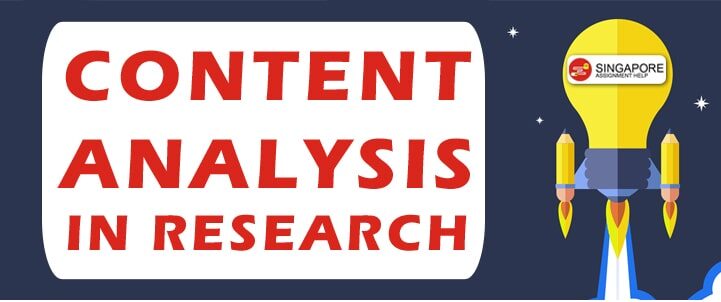Content Analysis in Research
Content analysis is a research methodology which you can use for identification of pattern in recorded communication. If you are master and graduate students performing the content analysis for the first time then you might find it difficult to execute it. Here, in this article, our professionals are providing you with a complete picture of content analysis in research.

Definition of Content analysis?
Content analysis can be referred to as research method which researcher utilize for identification of pattern in recorded communication. For conducting content analysis are required to gather systematic data from a set of texts which can be in the form of writing, oral and visual such as :
- Interview and speeches
- Magazines, books, and newspaper
- Content on web and Social media posts
- Films and Photograph
You can perform content analysis in both Qualitative and Quantitative research. In both types of research, you van categorize words, themes in the texts, and after that, you can easily analyze research results.
Hire a Professional Essay & Assignment Writer for completing your Academic Assessments
Native Singapore Writers Team
- 100% Plagiarism-Free Essay
- Highest Satisfaction Rate
- Free Revision
- On-Time Delivery
Advantages of content analysis
The different Advantages of content analysis are:
A) Unobtrusive Data collection
Researchers can easily perform analysis of communication and social interaction in which participants are not directly involved. So your presence as a researcher does not have any kind of influence on research results.
B) Transparent and replicable
The content analysis includes a systematic process in which another researcher can easily replicate and yield results with high reliability.
C) Highly flexible
Researchers can perform content analysis at any time, at any place. Content analysis is considered a cost-efficient way of analyzing content. About content analysis you only need to have access to suitable and right sources.
Disadvantages of analyzing research content
Few disadvantages of content analysis are:
1.) Reductive
Content analysis as a research method mainly emphasizes words or phrases in isolation in a few cases that could be reductive and have an ambiguous meaning.
2.) Subjective
The content analysis includes some level of subjective interpretations which can influence the reliability and validity of the research results and Conclusions.
3.) Time intensive
Doing coding of large volumes of text manually can be time-consuming.
Buy high-quality essays & assignment writing as per particular university, high school or college by Singapore Writers
How to conduct content analysis?
Before beginning to perform content analysis for your research, you are required to design Research Questions. You need to follow 5 steps these are:
Step 1: Selection of content for analysis
On the basis Research Question, you need to select texts which you will analyze. You are required to decide:
- The medium and genre
- Criterion for inclusion
- The parameters in terms of the data range, location, etc.
In case there are only a small amount of texts which meet your criterion, you need to analyze all of them. If there is a large volume of texts, you can make a selection of a sample.
Example of content analysis
To research media representations of male and female politicians, you can make decisions for analysis news articles and opinions pieces in the print newspapers between 2017 -2019. As this is a large number content, you need to make the choice of 3 major national newspaper and sample only Monday and Friday editions.
Step 2: Define the units and categories of analysis
At this you are required to determine the level at which you will require to analyze selected texts. It includes defining:
Units of meaning which will be coded. For example, if in case you are recording the frequency of individual words and phrases, the characteristics of an individual or appear in the texts.
Set of categories that you will utilize for coding. The categories could be objective. For instance, female, lawyer, mother, or more conceptual such as trustworthy, family-oriented, corrupt, etc.
In the context of the above example, you can analyze the politicians who appear in every article and the words or phrases which are utilized by the researcher for describing them. Based on research questions, you need to categorize them based on gender and the concept of trustworthiness. For obtaining more detailed information, researchers can do coding for other groups such as political parties, marital statuses or politicians, etc.
Step 3: Developing a set of rules for coding
The coding process includes arranging the units of meaning in already defined groups. Particularly with more conceptual grouping. It is very much essential for you to properly define a code of conduct for making sure that all texts are coded inconsistent manner.
Complying with the coding rules is very much crucial particularly when several researchers are participating. But if the researcher is recording the regulation then rules will help you in making the methodology more transparent and reliable.
At the time of thinking of category female politician it is very much essential for you to determine which title would be coded along with specific grouping (counselor, Mayor, governor, etc. Along with the term trustworthy you need to make decisions about which particular words or phrases relevant to trustworthiness would be relevant to trustworthiness egg, honest and reliable would be coded in this category.
Step 4: Coding the text according to rules
You need to go through every text and record all relevant information inappropriate categories. Researchers can do it manually or using computer programs such as Atlas.ti, diction, and QSR Nvivo which can be helpful about speeding up the procedure of counting and categorizing phrases or words.
By complying with coding rules, you are required to examine every newspaper article in the sample. You need to properly analyze newspaper articles in the sample. You are recording the characteristics of each politician mentioned, along with all words and phrases about trustworthiness which are utilized for describing them.
Step 5: Analysing the results and draw conclusions
Once coding is complete, the collection of data is examined analyzing finding patterns and drawing conclusions in response to research questions. You may utilize statistical analyses for finding correlations or tends, discuss your interpretations of the results. You need to make assumptions about the creators, background information, and audience of the texts.
The research results show that words or phrases which are relevant to trustworthiness appeared in similar sentences as male politicians in a more frequent manner. By analyzing the research results it has been concluded that male politicians are considered to be as more trustworthy as compared to female politicians. Such assumptions can have a significant influence on people’s opinions about females in politics.
What are the uses of content analysis in research?
You can utilize content analysis for finding out the purposes, messages, and influence of communication content. Researchers can also make assumptions related to the audience, producers, and text which they analyze.
Example of content analysis in Quantitative content
The researcher is performing a study for analyzing the significance of employment problems in political campaigns. Therefore, they have decided to analyze speeches given by different people during the campaign. They have decided to analyze the frequency of different terms such as unemployment, work, jobs, etc. You can utilize statistical analysis technique for identifying the differences over a period of time.
You can also utilize content analysis for analyzing Qualitative assumptions. Researcher for performing content analysis in research needs to make Qualitative assumptions by properly developing understanding about meaning and relationship between words and concepts.
Content analysis in Qualitative Research: Example
A researcher has undertaken a study for developing an understanding of employment issues in political campaigns. The investigator is required to locate the term unemployment in speeches. You are required to identify what other words speakers are using. You can analyze the relationship for developing a better understanding of intentions and targets of different campaigns.
You can apply content analysis to a wide range of texts. Researchers generally utilize content analysis for performing research in different fields such as media studies, cognitive science, social science, anthropology, and many social science disciplines. It has different possible objectives:
- Identification of correlations and patterns in how concepts are communicated.
- Developing understanding about the intentions of people, group.
- Find propaganda and biasness in communication.
- Reveal variations in communications in different contexts.
- Analyze the consequences of communication content like the flow of information.
Stuck with a lot of homework assignments and feeling stressed ? Take professional academic assistance & Get 100% Plagiarism free papers
Conclusion
It has been concluded from the above that content analysis is beneficial in terms of analysis of patterns in recorded communication. Another fact which has been discovered from the above is that content analysis can also be utilized for analyzing the influence of communication content or messages on communication content











